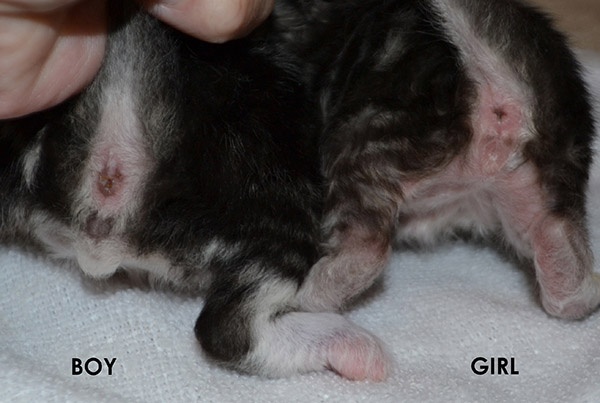Determining whether a cat is a boy or a girl can sometimes be tricky, especially when they are young kittens. While cats don’t have the obvious external characteristics humans do, there are several telltale signs you can look for. Whether you’ve just adopted a kitten or are simply curious about your feline friend’s gender, this guide will walk you through 15 ways to tell if a cat is male or female.
1. Examine the Genital Area
The most accurate way to determine a cat’s sex is by closely examining the genital area. The distance between the anus and genital opening is the key:
- Male Cats: Males will have a larger gap between the anus and their genital opening. Their genital opening is typically round or oval, and there may be a visible bulge or scrotum if the cat is not neutered.
- Female Cats: Female cats have a much smaller gap between the anus and the genital opening. The genital opening is a vertical slit.
2. Look for Testicles (In Unneutered Males)
In male cats that haven’t been neutered, the testicles are usually visible beneath the tail. These are more noticeable as the cat grows older, and they sit beneath the genital opening, making it easy to identify a male.
3. Size and Build of the Cat
Adult male cats are often larger and more muscular than females. Males typically have broader shoulders and a thicker neck. Females, in contrast, tend to have a more delicate and slender build.
4. Behavioral Clues
While behavior is not a surefire way to tell a cat’s sex, there are some patterns to watch for:
- Male Cats: Unneutered males are more likely to exhibit territorial behaviors, like spraying urine to mark their territory. They can also be more aggressive and vocal, especially during mating season.
- Female Cats: Female cats, especially those in heat, will often display louder, more persistent meowing or yowling to attract a mate.
5. Spaying and Neutering History
If the cat has already been spayed or neutered, gender differences might not be as easy to spot. However, neutered male cats may still have a larger space between their anus and genital area. Female cats, if spayed, will not have the vertical slit of the genital opening.
6. Head Shape
Male cats, especially unneutered ones, tend to have larger, rounder heads compared to females. This is due to the presence of testosterone, which also causes a thicker, more robust neck.
7. Vocalization Patterns
While both male and female cats can be vocal, male cats tend to be more vocal during mating season. Unneutered male cats often exhibit loud, distinctive yowls as they search for a mate.
8. Facial Features
Male cats often have more pronounced and angular facial features, particularly in the jaw area. This is particularly noticeable in larger breeds, where males may have broader faces and stronger jawlines.
Wacth on video
9. Behavior Toward Other Cats
Unneutered male cats are often more aggressive or dominant when interacting with other cats, especially other males. They may engage in fights or try to assert dominance. Female cats, particularly those that are spayed, tend to be less confrontational.
10. Look for “Tomcat” Characteristics
Tomcats (adult male cats) often have distinguishing characteristics such as a rougher, thicker coat and a more muscular physique. This is especially true in unneutered male cats who may also exhibit stronger odors, especially around the neck.
11. Breeding Tendencies
Male cats generally have a stronger desire to roam in search of mates. If a cat is often trying to escape the house, it’s likely a male, especially if it’s unneutered. Female cats in heat may also try to escape, but it’s usually to find a mate rather than roam aimlessly.
12. Look for Pregnancy Signs in Females
If the cat is a female and is pregnant, you’ll likely notice the signs within a few weeks. A pregnant cat will develop a noticeably enlarged belly and her nipples will become more prominent.
13. Examine the Tail Area
In male cats, especially those that have not been neutered, there may be a noticeable bulge or swelling at the base of the tail, where the testicles are located. Female cats do not have this characteristic.
14. Growth Patterns in Kittens
Kittens are harder to distinguish, but as they grow, males tend to develop larger heads, thicker necks, and more muscular bodies compared to females. You’ll also notice that male kittens are generally more active and curious, which is linked to their higher testosterone levels.
15. Consult a Veterinarian
If you’re still unsure about your cat’s gender, the best option is to consult a veterinarian. Vets are skilled in identifying the sex of cats and can help with accurate identification, especially in kittens. They will also be able to advise you on the cat’s health and provide any necessary medical recommendations.

Conclusion
Determining whether a cat is male or female is not always a straightforward task, especially when they are young. However, by examining the genital area, observing physical traits, and paying attention to behavioral patterns, you can often tell whether your cat is a boy or a girl. If you’re still unsure, a visit to the vet is always a great option for a precise answer. Understanding your cat’s sex is important for its care and health, particularly when considering neutering or spaying.



